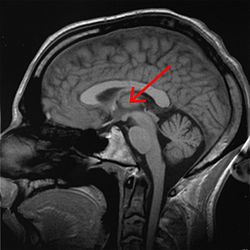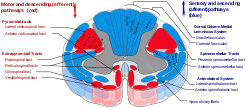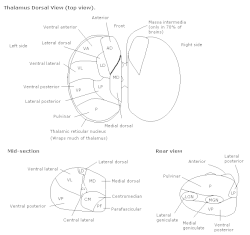Thalamus

The thalamus (plural: thalami; from Greek: θάλαμος, trans. "inner chamber")[1] is a midline symmetrical structure in the brains of vertebrates. The thalamus is situated between the midbrain and cerebral cortex.
Overview
The thalamus relays sensory and motor signals to the cerebral cortex,[2][3] and regulates consciousness, sleep and alertness.
The thalamus sits above the hypothalamus but below the cerebral cortex. It is a collection of nuclei with various functions. It acts as a relay station, gathering sensory information – except olfactory – and passes it on to the cerebral cortex.
There are action systems[clarification needed] for various types of behaviour, including but not limited to eating, drinking, defecation and copulation.[4] These behaviours satisfy short-term needs, and are called 'consummatory' behaviours.
Functions
The thalamus has many functions. First of all, it acts as a relay station, or hub. It relays information between subcortical areas and the cerebral cortex.[5] In particular, every sensory system except smelling has a thalamic nucleus that receives sensory signals and sends them to the related areas in the cortex.
Examples
For sight, inputs from the retina are sent to the thalamus, which in turn sends them to the visual cortex in the occipital lobe.
Sensory processing
The thalamus is believed to process sensory information as well as to relay it: each of the main sensory relay areas gets strong feedback from the cerebral cortex.[6]
Sleep regulation
The thalamus also plays an important role in regulating states of sleep and wakefulness.[7] Thalamic nuclei have strong connections with the cerebral cortex. These circuits are believed to be involved with consciousness.[8] The thalamus plays a major role in regulating arousal, the level of awareness, and activity. Damage to the thalamus can lead to permanent coma.[9]
Basal ganglia
The thalamus has a role in the basal ganglia system, but the mechanism is poorly understood. The thalamus has been thought of as a "relay" that just forwards signals to the cerebral cortex. But research suggests that thalamus is more selective.[10]
Sensory systems
Many functions are linked to regions of the thalamus. This is the case for most sensory systems, except the olfactory system, such as the auditory, somatic sensory system, visceral, eating and visual systems. There are specific lesions cause specific sensory deficits. A big role of the thalamus is the support for motor and language systems. Much of the circuitry for these systems is shared with the thalamus. The thalamus is functionally connected to the hippocampus.[11] This is part of the hippocampal system which is crucial for human episodic event memory.[12][13][14]
Motor control
The information for motor control is a network involving the thalamus as a subcortical motor center.[15] In the brains of primates, the thalamus provides the specific channels from the basal ganglia and cerebellum to the cortical motor areas.[16][17][18]
Research
In an investigation of the eye movement motor response in three monkeys, the thalamic regions were found to cause antisaccade eye movement. That is the ability to inhibit the reflexive jerking movement of the eyes in the direction of a presented stimulus.[19][20] They still look in the direction of the stimulus, but do so in a more controlled manner.
Recent findings
Recent findings suggested that the mediodorsal (MD) thalamus may "amplify the connectivity (signaling strength) of just the circuits in the cortex needed for the current context, aiding in the flexibility – of the mammalian brain – to make complex decisions by wiring the many associations on which decisions depend into weakly connected cortical circuits."[21]
Researchers also found that "enhancing MD activity magnified the ability of mice to think".[21] This lowered by more than 25 percent their error rate in deciding which conflicting sensory stimuli to follow to find the reward."[22]
Summary
In short, the thalamus helps to make mammals more effective at making decisions and living in their natural environment.
The half-second delay
The thalamus is a key area which is involved in what is known as the "half-second delay". This is a perceptual illusion which has only recently been discovered.[23][24] The discovery is as follows: we perceive events in the world as instantaneous. They happen when we see (hear, sense) them happening. But the processing of visual signals at least is what the thalamus does.
Experientially, we see events happening (so we think) without any delay. But in reality it takes half a second for the brain to organise the data which comes in from, let us say, vision. However, we do not sense that half-second delay at all.
Our perception of events is that we see them as they happen,[25] which applies to consciousness and conscious behaviour. Automatic responses to sudden pain happen instantaneously (bare foot on a pin for example), but they are actually perceived a moment after.
Thalamus Media
Thalamic nuclei. Metathalamus labelled MTh.(Left thalamus viewed from left.)
Medial nuclei of the left thalamus.Key: CeM Central Medial. CL Central Lateral. CM CentroMedian. MD Medial Dorsal. MV MedioVentral Reuniens. Pf Parafascicular. (Lateral view shows sagittal section through left thalamus)
Lateral nuclei of the left thalamus.Key: VA Ventral Anterior. VL Ventral Lateral. VM Ventral Medial. VPI Ventral PosteroInferior. VPL Ventral PosteroLateral. VPM Ventral PosteroMedial. (Medial view shows sagittal section through left thalamus.)
The thalamus is connected to the spinal cord via the spinothalamic tract
Diagram showing the anterior and lateral spinothalamic tracts within the spinal cord
References
- ↑ Douglas Harper - index & University of Washington Faculty Web Server & Search engine search page + Perseus Project tufts.edu Retrieved 2012-02-09
- ↑ Sherman, S. (2006). "Thalamus". Scholarpedia. 1 (9): 1583. Bibcode:2006SchpJ...1.1583S. doi:10.4249/scholarpedia.1583.
- ↑ S. M. Sherman & Ray Guillery -ISBN 0-12-305460-5 → Elsevier B.V [Retrieved 2012-02-10]
- ↑ Jones E.G. 1985. The thalamus. Plenum Press. ISBN 9780306418563 [1]
- ↑ Gazzaniga; Ivry; Mangun, Michael, S.; Richard B.; George R. (2014). Cognitive Neuroscience - The Biology of The Mind. New York: W.W. Norton. pp. 45. ISBN 978-0-393-91348-4.
{{cite book}}: CS1 maint: multiple names: authors list (link) - ↑ "The thalamus, middleman of the brain, becomes a sensory conductor". The University of Chicago Medicine. Retrieved 10 Sep 2020.
- ↑ Steriade, Mircea; Llinás, Rodolfo R. (1988). "The functional states of the thalamus and the associated neuronal interplay". Physiological Reviews. 68 (3): 649–742. doi:10.1152/physrev.1988.68.3.649. PMID 2839857.
- ↑ Coma and disorders of consciousness ISBN 978-1-447-12439-9 p. 143
- ↑ The Neurology of Consciousness: cognitive neuroscience and neuropathology ISBN 978-0-123-74168-4 p. 10
- ↑ Leonard, Abigail W. (August 17, 2006). "Your brain boots up like a computer". LiveScience.
- ↑ Stein, Thor; Moritz, Chad; Quigley, Michelle; Cordes, Dietmar; Haughton, Victor; Meyerand, Elizabeth (2000). "Functional connectivity in the thalamus and hippocampus studied with functional MR imaging". American Journal of Neuroradiology. 21 (8): 1397–401. PMC 7974059. PMID 11003270.
- ↑ Aggleton, John P.; Brown, Malcolm W. (1999). "Episodic memory, amnesia, and the hippocampal–anterior thalamic axis" (PDF). Behavioral and Brain Sciences. 22 (3): 425–44, discussion 444–89. doi:10.1017/S0140525X99002034. PMID 11301518. S2CID 11258997.
- ↑ Aggleton, John P.; O'Mara, Shane M.; Vann, Seralynne D.; Wright, Nick F.; Tsanov, Marian; Erichsen, Jonathan T. (2010). "Hippocampal-anterior thalamic pathways for memory: Uncovering a network of direct and indirect actions". European Journal of Neuroscience. 31 (12): 2292–307. doi:10.1111/j.1460-9568.2010.07251.x. PMC 2936113. PMID 20550571.
- ↑ Burgess, Neil; Maguire, Eleanor A; O'Keefe, John (2002). "The human hippocampus and spatial and episodic memory". Neuron. 35 (4): 625–41. doi:10.1016/S0896-6273(02)00830-9. PMID 12194864. S2CID 11989085.
- ↑ Evarts, E.V; Thach, W T (1969). "Motor mechanisms of the CNS: cerebrocerebellar interrelations". Annual Review of Physiology. 31: 451–98. doi:10.1146/annurev.ph.31.030169.002315. PMID 4885774.
- ↑ Orioli, PJ; Strick, PL (1989). "Cerebellar connections with the motor cortex and the arcuate premotor area: An analysis employing retrograde transneuronal transport of WGA-HRP". The Journal of Comparative Neurology. 288 (4): 612–26. doi:10.1002/cne.902880408. PMID 2478593. S2CID 27155579.
- ↑ Asanuma C, Thach WT, Jones EG (May 1983). "Cytoarchitectonic delineation of the ventral lateral thalamic region in the monkey". Brain Research. 286 (3): 219–35. doi:10.1016/0165-0173(83)90014-0. PMID 6850357. S2CID 25013002.
- ↑ Kurata, K (2005). "Activity properties and location of neurons in the motor thalamus that project to the cortical motor areas in monkeys". Journal of Neurophysiology. 94 (1): 550–66. doi:10.1152/jn.01034.2004. PMID 15703228.
- ↑ "The Antisaccade - A Review of Basic Research and Clinical Studies". Archived from the original on 2017-09-16. Retrieved 2014-01-21.
- ↑ Kunimatsu, J; Tanaka, M (2010). "Roles of the primate motor thalamus in the generation of antisaccades" (PDF). Journal of Neuroscience. 30 (14): 5108–17. doi:10.1523/JNEUROSCI.0406-10.2010. PMC 6632795. PMID 20371831. Archived from the original (PDF) on 2021-11-10. Retrieved 2021-03-24.
- ↑ 21.0 21.1 "New role discovered for brain region" (in en-US). Neuroscience News. 2017-05-03. http://neurosciencenews.com/pfc-decision-making-6576/. Retrieved 2017-12-03.
- ↑ Schmitt, L. Ian; Wimmer, Ralf D.; Nakajima, Miho; Happ, Michael; Mofakham, Sima; Halassa, Michael M. (11 May 2017). "Thalamic amplification of cortical connectivity sustains attentional control". Nature. 545 (7653): 219–223. Bibcode:2017Natur.545..219S. doi:10.1038/nature22073. ISSN 1476-4687. PMC 5570520. PMID 28467827.
- ↑ References can be got from Norretranders T. 1999. The user illusion: cutting consciousness down to size. Penguin, London, chapter 8.
- ↑ Libet, Benjamin 1965. Cortical activation in conscious and unconscious experience. Perspectives in Biology and Medicine. 9, 77–86.
- ↑ Libet B; Pearl D.K; Morledge D; Gleason D.A; Morledge Y & Barbaro N.M. 1991. Control of the transition from sensory detection to sensory awareness in Man by the duration of a thalamic stimulus. Brain 14, 1731–57.









